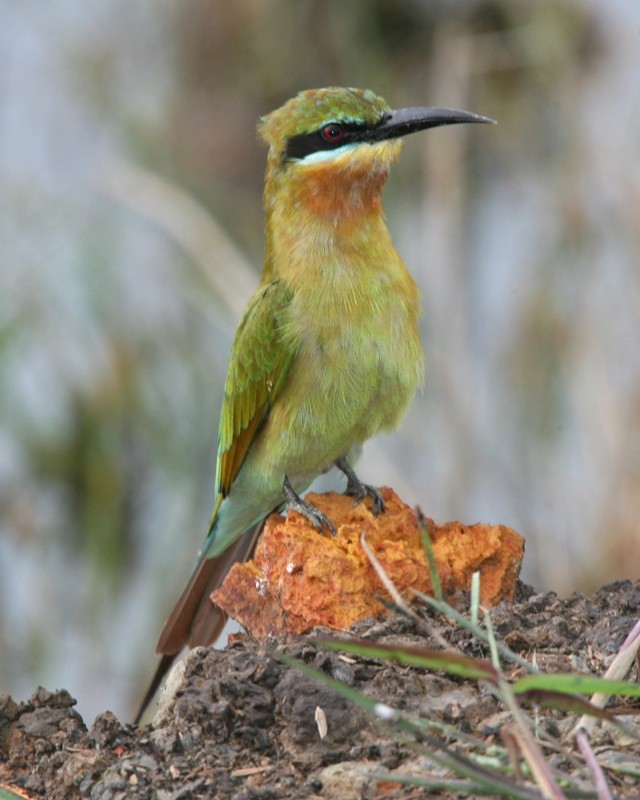Blue-tailed Bee-eater
A species of Typical Bee-eaters Scientific name : Merops philippinus Genus : Typical Bee-eaters
Blue-tailed Bee-eater, A species of Typical Bee-eaters
Botanical name: Merops philippinus
Genus: Typical Bee-eaters
Content
Description People often ask General Info
 Photo By Lip Kee , used under CC-BY-SA-2.0 /Cropped and compressed from original
Photo By Lip Kee , used under CC-BY-SA-2.0 /Cropped and compressed from original Description
This species, like other bee-eaters, is a richly coloured, slender bird. It is predominantly green; its face has a narrow blue patch with a black eye stripe, and a yellow and brown throat; the tail is blue and the beak is black. The three outer toes are united around their bases. It can reach a length of 23–26 cm, including the two elongated central tail feathers which can jut two inches more than the remaining ten feathers. Sexes are alike. This species is usually found near water and like other bee-eaters it predominantly eats flying insects, especially bees (as large as the Xylocopa sp.), wasps and hornets, which are caught in the air by sorties from an open perch. They may also forage in flight over estuaries, backwaters and even over the sea but not far from the coast. This species probably takes bees and dragonflies in roughly equal numbers. The insects that are caught are beaten on the perch to kill and break the exoskeleton. This habit is seen in many other members of the order Coraciiformes. They call mainly in flight with a rolling chirping whistling teerp. The only confusable species within its range is the blue-cheeked bee-eater which however tends to be found in drier areas. The blue-tailed differs in having the rump and tail blue rather than green and black. The undertail feathers are bluish rather than green in the blue-cheeked. The blue cheek patch is much smaller while the chestnut on the throat and breast darker and covering a larger area. They breed in April to May in India nesting colonially with closely placed nest holes in a vertical mudbank or even burrowing into gently sloping land. They tend to choose sandy and sandy clay loams but avoid heavier clay loams. They also prefer clear mud banks without any vegetation cover. In Sri Lanka, they have been noted to breed in artificial sand dunes created by dredging of sea sand. The nest tunnel can run nearly 2 metres deep. About 5 to 7 near spherical eggs are laid. Both the male and the female take care of the eggs. The parents guard the nest to prevent intraspecific brood parasitism and extra pair copulation. These birds also feed and roost communally. One or two helpers may join the breeding pair after incubation begins. Although males and females appear similar to the human eye, males tend to have longer central tail feather extensions and UV reflectance studies demonstrate that healthy males had darker chestnut throats and brighter green body plumage while females showed brighter blue rumps and yellow chins. 
Size
29 cm
Colors
Brown
Black
Green
Yellow
White
Blue
Life Expectancy
6-7 years
Nest Placement
Burrow
Feeding Habits
Blue-tailed Bee-eater primarily feeds on flying insects, especially dragonflies. Blue-tailed Bee-eater's hunting technique involves catching prey mid-air during flight. They display a preference for honeybees, flies, wasps, hornets, and beetles, showcasing their aerial agility and specialized hunting behavior.
Habitat
Blue-tailed Bee-eater thrive in a mix of natural and artificial habitats spanning subtropical and tropical regions. Preferring proximity to water, they are commonly found in mangroves, tidal estuaries, wetland ecosystems including freshwater lakes, and rivers. Their habitat range extends to dry and moist lowland forests, forest clearings, and river valleys. Blue-tailed Bee-eater also adapt to human-altered environments such as arable lands, plantations, pastures, rural gardens, urban parks, and suburban areas, showcasing their versatile nature in various landscapes.
Dite type
Insectivorous
People often ask
General Info
Feeding Habits
Bird food type
Distribution Area
The species has a patchy breeding distribution across India, Myanmar, and parts of Southeast Asia. In India they are known to breed in several of the river valleys including those of the Godavari, Kaveri, Tunga Badra and Krishna rivers. They also nest in the eastern parts of Sri Lanka. Blue-tailed bee-eaters are seasonal in many parts of their range and are known to migrate diurnally en masse at some places like Tanjung Tuan (W. Malaysia) and Promsri Hill (southern Thailand). They are winter visitors in parts of Malaysia and peninsular India. The non-breeding ranges of the blue-cheeked bee-eater and blue-tailed overlap in some parts of Gujarat and western peninsular India. 
Species Status
Not globally threatened.
Scientific Classification
Phylum
Chordates Class
Birds Family
Bee-eaters Genus
Typical Bee-eaters Species
Blue-tailed Bee-eater